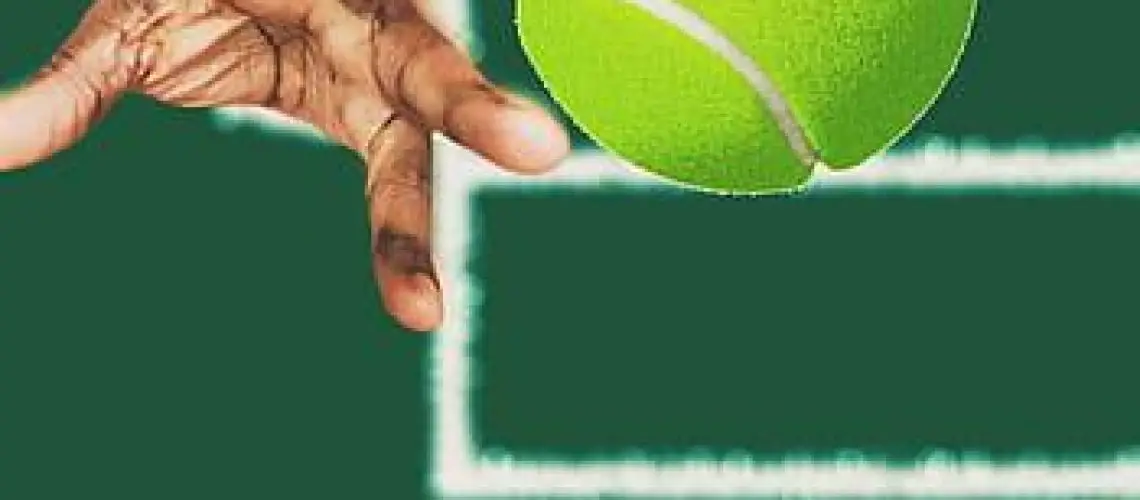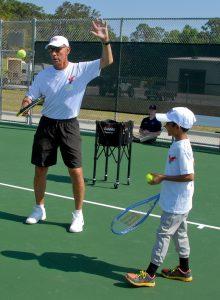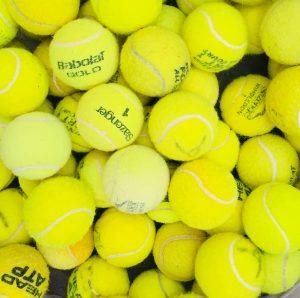We may earn money or products from the companies mentioned in this post.
Introduction

In the world of tennis, there is a unique playing style known as the “pusher” A pusher is a player who relies on consistency, precision, and strategic shot placement rather than power or aggressive tactics Their goal is to frustrate their opponents by forcing them to make mistakes and gradually wear them down
Definition of a pusher in tennis
A pusher’s playing style can be characterized by their ability to hit consistent shots with moderate pace and spin They focus on keeping the ball in play rather than going for winners Pushers often employ defensive strategies such as slicing the ball and hitting high lobs to disrupt their opponent’s rhythm
Common frustrations when playing against pushers
Playing against a pusher can be incredibly frustrating for many players The constant barrage of consistent shots can make it challenging to find opportunities to attack Additionally, pushers excel at changing the pace of the game, making it difficult for opponents to get into a rhythm This disruption can lead to errors and mental fatigue
Purpose of the article

The purpose of this article is twofold: firstly, we aim to address common questions that tennis players have when facing pushers on the court We will provide insights into how best to approach these matches and overcome the challenges they present
Secondly, we will offer effective strategies and techniques that you can employ when playing against pushers These methods will help you not only neutralize their tactics but also take control of the match by turning their strengths into weaknesses
In conclusion, understanding how pushers operate and having effective strategies in place are crucial when facing them on the tennis court With the right mindset and techniques at your disposal, you can turn what may initially seem like a frustrating experience into an opportunity for growth and success
Understanding Pusher Tactics

When it comes to tennis, there are various playing styles that players adopt to gain an advantage over their opponents One such style is the pusher tactic, which can be highly effective when executed correctly Let’s dive into the intricacies of pusher tactics and how they can give players an edge on the court
Consistent Ball Returns
The hallmark of a pusher is their ability to consistently return the ball, often frustrating their opponents By focusing on maintaining a steady rhythm and minimizing unforced errors, pushers force their opponents to work harder for points
This relentless returning not only tests the physical stamina of their opponents but also has a psychological impact The constant pressure and persistence can wear down even the most skilled players, leading to frustration and mental lapses on the opponent’s side
Defensive Playstyle
In contrast to power-based playstyles, pushers prioritize placement over sheer power Rather than relying on aggressive shots, they strategically place the ball in areas that exploit their opponent’s weaknesses
This defensive approach forces opponents out of their comfort zones and disrupts their game plans Pushers excel at reading their opponent’s movements and adjusting their shots accordingly, making it difficult for aggressive players to overpower them
Court Positioning and Shot Selection
A key aspect of pusher tactics is staying behind the baseline during rallies By maintaining this position, pushers limit attacking opportunities for their opponents while maximizing defensive coverage
- Limiting Attacking Opportunities: Staying behind the baseline allows pushers to effectively counter aggressive shots from opponents by quickly retrieving balls with well-timed defensive strokes
- Effective Use of Lobs and Drop Shots: Pushers employ strategic shot selection, including well-executed lobs and drop shots, to disrupt their opponents’ rhythm These shots can catch aggressive players off guard and force them into uncomfortable positions on the court
Mastering pusher tactics requires a combination of consistency, defensive prowess, and strategic shot selection It’s a style that can frustrate opponents while providing opportunities for pushers to capitalize on weaknesses By understanding these tactics, players can adapt their own strategies or develop effective countermeasures when facing pushers on the court
Strategies to Beat Pushers in Tennis

When facing pushers on the tennis court, it’s important to have a game plan that allows you to overcome their relentless consistency Here are some strategies that can help you gain the upper hand and come out victorious:
Maintaining patience and composure
To beat pushers, it’s crucial to stay calm and composed throughout the match This means not getting frustrated by their ability to keep returning your shots and staying patient during long rallies By maintaining your focus and avoiding unforced errors, you can prevent them from gaining an advantage
1 Handling long rallies
Pushers excel at extending points with their consistent shot placement To handle these prolonged exchanges, focus on maintaining a consistent depth in your shots while mixing up the pace and angle of your shots to keep them guessing
2 Staying mentally strong during points
Mentally preparing yourself for each point is key when facing pushers Stay positive and avoid dwelling on missed opportunities or challenging moments By staying mentally strong, you can maintain confidence in your abilities and make smart decisions under pressure
Attacking their weaknesses
To break down a pusher’s game, it’s essential to identify patterns in their playstyle and exploit their weaknesses effectively
1 Identifying patterns in their playstyle
Closely observe how pushers position themselves on the court, paying attention to any recurring shot selections or tendencies they display This will help you anticipate their next move and adjust your strategy accordingly
2 Targeting weaker shots, such as backhands or volleys
Every player has weaker shots that you can exploit Once you identify a specific weakness, aim to direct your shots towards those areas, forcing them to make difficult returns and putting them on the defensive
Varying your own shot selection
To keep pushers off balance, incorporate a variety of shots into your game
1 Incorporating slice, topspin, and flat shots
By mixing up the spin and pace of your shots, you can disrupt their rhythm and force them to adjust their footwork and timing Utilize slice shots to keep the ball low and make it harder for them to generate power
2 Utilizing drop shots and lobs to keep them off balance
The element of surprise can be a powerful weapon against pushers Incorporate drop shots when they least expect it or use well-timed lobs to catch them out of position, giving yourself an opportunity to take control of the point
Controlling the pace of the game
To beat pushers, it’s important to dictate the tempo of the match and prevent them from settling into their comfort zone
1 Dominating rallies with powerful groundstrokes
Showcase your strong groundstrokes by hitting with power and depth during rallies This will put pressure on pushers and limit their ability to counterattack effectively
2 Moving them around the court with well-placed shots
Avoid being predictable in your shot placement Aim for corners or angles that force pushers to cover more ground, making it harder for them to maintain their defensive stance
Improving your net game
Taking control at the net can disrupt a pusher’s rhythm and put them under pressure
1 Applying pressure by approaching the net
By taking opportunities to approach the net, you force pushers to hit more difficult passing shots This increases your chances of winning points outright or putting yourself in a favorable position for an easy volley or overhead
2 Practicing volleys, overheads, and half-volleys
To excel at the net game, dedicate time to practicing volleys, overheads, and half-volleys Mastering these techniques will allow you to finish points quickly or keep pushers on their toes with well-placed shots
Tips for Practicing Against Pushers

Facing pushers on the tennis court can be a challenging experience Their strategic game style, characterized by consistent ball placement and defensive shots, can throw off even the most skilled players To counter their tactics effectively, it’s crucial to adapt your training drills and mindset Here are some insightful tips to help you level up your game:
Adjusting training drills to mimic pusher tactics
1 Practicing long rallies with consistent ball placement: Pushers excel at keeping the ball in play, forcing you to make mistakes By incorporating extended rally drills into your practice sessions, you can improve your endurance and accuracy while getting accustomed to their relentless consistency
2 Emulating defensive shots, such as lobs and slices: Pushers thrive on frustrating opponents with well-placed defensive shots like lobs and slices By practicing these specific shot techniques during training, you’ll be better prepared to counter their strategies during an actual match
Participating in match play against pushers
1 Familiarizing oneself with the pusher’s playing style: The best way to understand how to handle a pusher is through firsthand experience Seek out opportunities to play against them in match situations, observe their patterns of play closely, and identify any weaknesses or predictable tendencies they may have
2 Adapting and implementing strategies learned during practice: Once you’ve analyzed a pusher’s playing style through match play and practice sessions, it’s important to adapt your strategies accordingly Implementing tactical adjustments like hitting more aggressively or varying shot selection will keep them off balance and disrupt their rhythm
Continuously working on mental strength
1 Developing coping mechanisms for frustration: Playing against pushers can be mentally exhausting, as their consistent game style often leads to frustration To combat this, develop coping mechanisms such as deep breathing or focusing on positive self-talk to stay mentally strong and composed throughout the match
2 Staying focused and composed throughout the match: Pushers aim to disrupt your rhythm and concentration Practicing mental focus techniques, like visualizing successful shots or maintaining a routine between points, will help you stay in control of your emotions and perform at your best
Setting realistic expectations and goals
1 Recognizing progress made over time: Overcoming pushers requires patience and persistence Acknowledge the small victories along the way, such as winning a few more points or improving shot placement Celebrating these milestones will keep you motivated on your journey to mastering the art of playing against pushers
2 Remaining patient during the learning process: It’s important to remember that developing effective strategies against pushers takes time Avoid getting discouraged by setbacks or losses, and maintain a positive mindset that appreciates every opportunity for growth
By implementing these tips into your training regimen and match play, you’ll gradually become more adept at handling pusher opponents Remember, it’s not just about physical skills but also mental fortitude that will help you rise above any challenge on the court!
Useful Links

How to beat pushers? : r/tennis
Beating Pushers Archives
How to Beat a Tennis Lobber (aka, the Pusher …
Beating pushers – Drills and Strategies
How to Play and Beat a Tennis Pusher
Distance Learning with Paul & Prakash: How to beat a …
5 Ways to Beat a Pusher – Tennis – ACTIVE
How To Beat Tennis Pushers
Great Tips On How To Beat A Pusher
The Pusher’s Strategy is Better Than Yours
How To Beat Pushers
How to Beat a Pusher or Moonballer in Tennis?
How To Beat Pushers – Tennis Lesson
How to beat a pusher – Tom Lodziak Table Tennis Coaching
How to Beat Pushers: Essential Tennis Podcast #158
How To Beat The Dinker – Afini Tennis USA
How to Beat the Pusher in Tennis?






